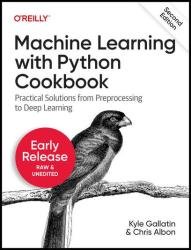 Название: Machine Learning with Python Cookbook: Practical Solutions from Preprocessing to Deep Learning, 2nd Edition (Fourth Early Release)
Название: Machine Learning with Python Cookbook: Practical Solutions from Preprocessing to Deep Learning, 2nd Edition (Fourth Early Release)Автор: Kyle Gallatin, Chris Albon
Издательство: O’Reilly Media, Inc.
Год: 2023-01-18
Страниц: 223
Язык: английский
Формат: pdf, epub (true), mobi
Размер: 10.1 MB
This practical guide provides more than 200 self-contained recipes to help you solve machine learning challenges you may encounter in your work. If you're comfortable with Python and its libraries, including pandas and scikit-learn, you'll be able to address specific problems all the way from loading data to training models and leveraging neural networks.
Each recipe in this updated edition includes code that you can copy, paste, and run with a toy dataset to ensure it works. From there, you can adapt these recipes according to your use case or application. Recipes include a discussion that explains the solution and provides meaningful context. Go beyond theory and concepts by learning the nuts and bolts you need to construct working machine learning applications.
NumPy is a foundational tool of the Python machine learning stack. NumPy allows for efficient operations on the data structures often used in machine learning: vectors, matrices, and tensors. While NumPy is not the focus of this book, it will show up frequently throughout the following chapters. This chapter covers the most common NumPy operations we are likely to run into while working on machine learning workflows. NumPy’s main data structure is the multidimensional array. A vector is just an array with a single dimension. In order to create a vector, we simply create a one-dimensional array. Just like vectors, these arrays can be represented horizontally (i.e., rows) or vertically (i.e., columns).
A frequent situation in machine learning is having a huge amount of data; however, most of the elements in the data are zeros. For example, imagine a matrix where the columns are every movie on Netflix, the rows are every Netflix user, and the values are how many times a user has watched that particular movie. This matrix would have tens of thousands of columns and millions of rows! However, since most users do not watch most movies, the vast majority of elements would be zero. A sparse matrix is a matrix in which most elements are 0. Sparse matrices only store nonzero elements and assume all other values will be zero, leading to significant computational savings.
You'll find recipes for:
Vectors, matrices, and arrays
Working with data from CSV, JSON, SQL, databases, cloud storage, and other sources
Handling numerical and categorical data, text, images, and dates and times
Dimensionality reduction using feature extraction or feature selection
Model evaluation and selection
Linear and logical regression, trees and forests, and k-nearest neighbors
Support vector machines (SVM), naive Bayes, clustering, and tree-based models
Скачать Machine Learning with Python Cookbook, 2nd Edition (Fourth Early Release)